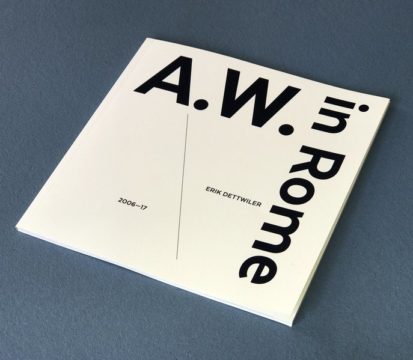This photographic cycle is related to a retrospective exhibition of Andy Warhol held at the Chiostro del Bramante—a singular example of Renaissance architecture in Rome projected by Bramante at the beginning of the 16th century. The exhibition’s ambiguous title “Repent and Sin no More”1 examined an undisclosed aspect of Warhol’s relationship towards spirituality and religion. The public relation concept for the show depicted a self-portrait of the artist. Countless advertising surfaces all over Rome displayed Andy Warhol’s portrait—from the city’s center to its vast outskirts. My interest was prompted by this obvious reciprocity of the Pop artist’s presence in the public realm, in the original space where goods are usually promoted. This paradox layering of the represented art—consisting of an oeuvre which implies on consumerism and advertisements—matching with the world of commerce, quoted by Warhol in the first place, intrigued me.
The artists’s head shot appearing as advertisement virtualy juxtaposed the various aspects of Warhol’s artistic concepts with the reality of everyday life. The Pop art image mingled in a synergetic way with the street-names on the advertising surfaces. The names were dedicated to late intellectuals, philosophers, politicians, artists, famous people in general (another facet in Warhol’s thematic complex) or to other particularities of the Italian history.
This photographic cycle is related to a retrospective exhibition of Andy Warhol, held at the Chiostro del Bramante in Rome—a singular example of Renaissance architecture, projected by Bramante at the beginning of the 16th century. The exhibition’s ambiguous title “Repent and Sin no More” examined an undisclosed aspect of Warhol’s relationship towards spirituality and religion. The public relation concept for the show depicted a self-portrait of the artist. Subsequently numerous advertising surfaces all over Rome displayed Warhol’s portrait—from the city’s center to its vast outskirts. My interest was prompted by the obvious reciprocity of pop art on billboards. A place where goods and products are usually promoted. This paradox layering of the represented art intrigued me. An artistic œuvre, which implies on consumerism and advertisement, is blended here into the world of commerce.
The artists’s head shot—appearing here as an advertisement—virtually juxtaposed various aspects of Warhol’s artistic concepts with the reality of everyday life. Besides the pop art image also mingled synergistically with the street names, heading the respective advertising surfaces. Names, dedicated to late intellectuals, philosophers, politicians, artists, famous people in general (another facet in Warhol’s thematic complex) or to other particularities of Italian history.
- Veröffentlicht am Donnerstag 11. Mai 2017 von Edition Haus am Gern
- ISBN: 9783952464212
- 60 Seiten
- Genre: Hardcover, Kunst, Softcover
